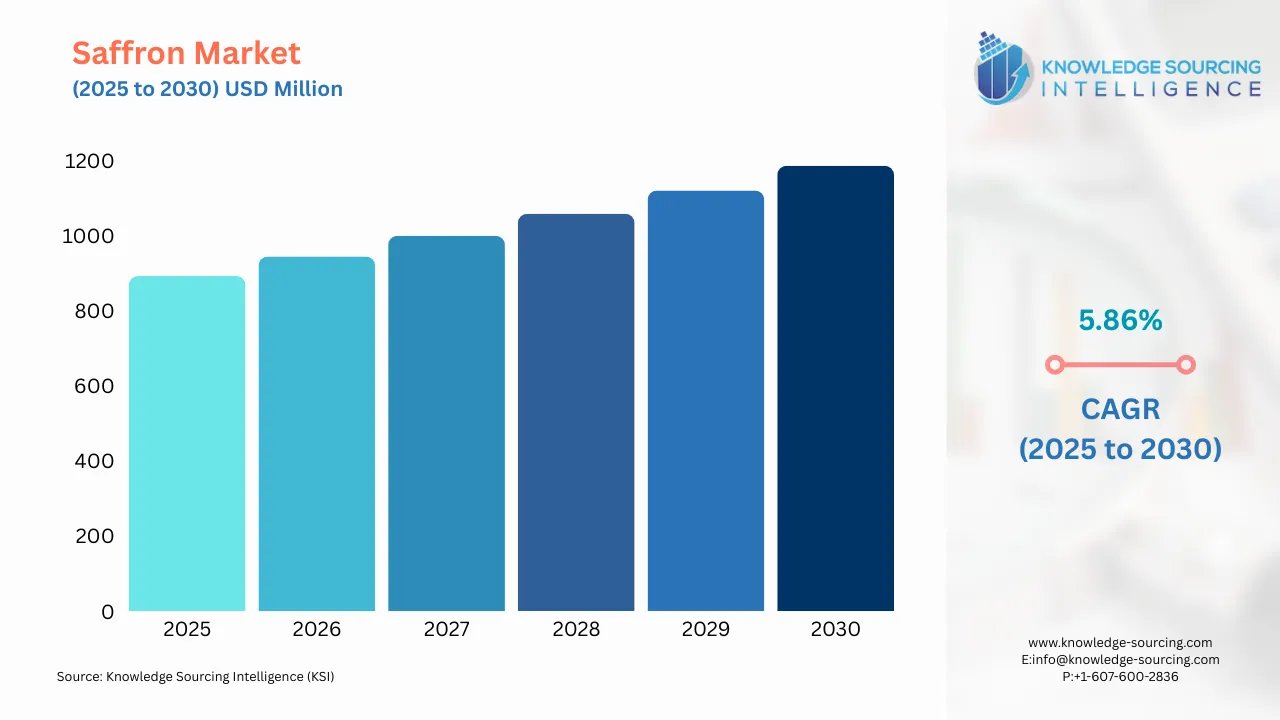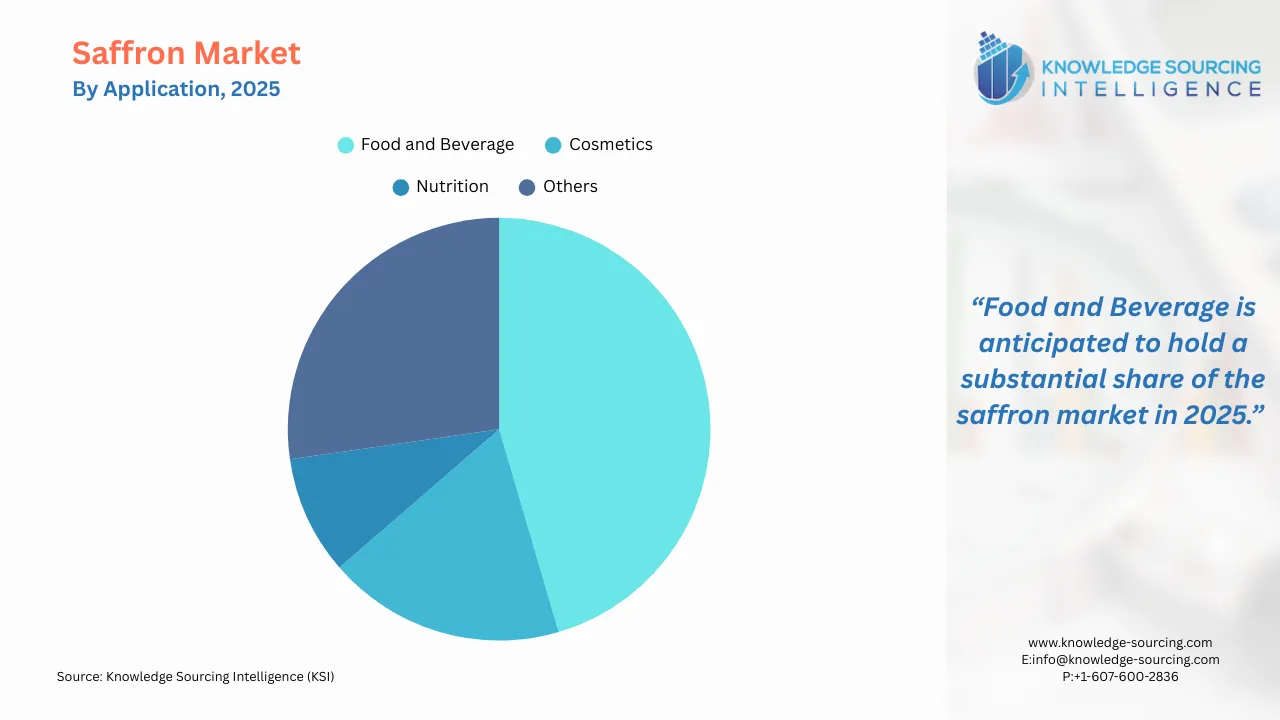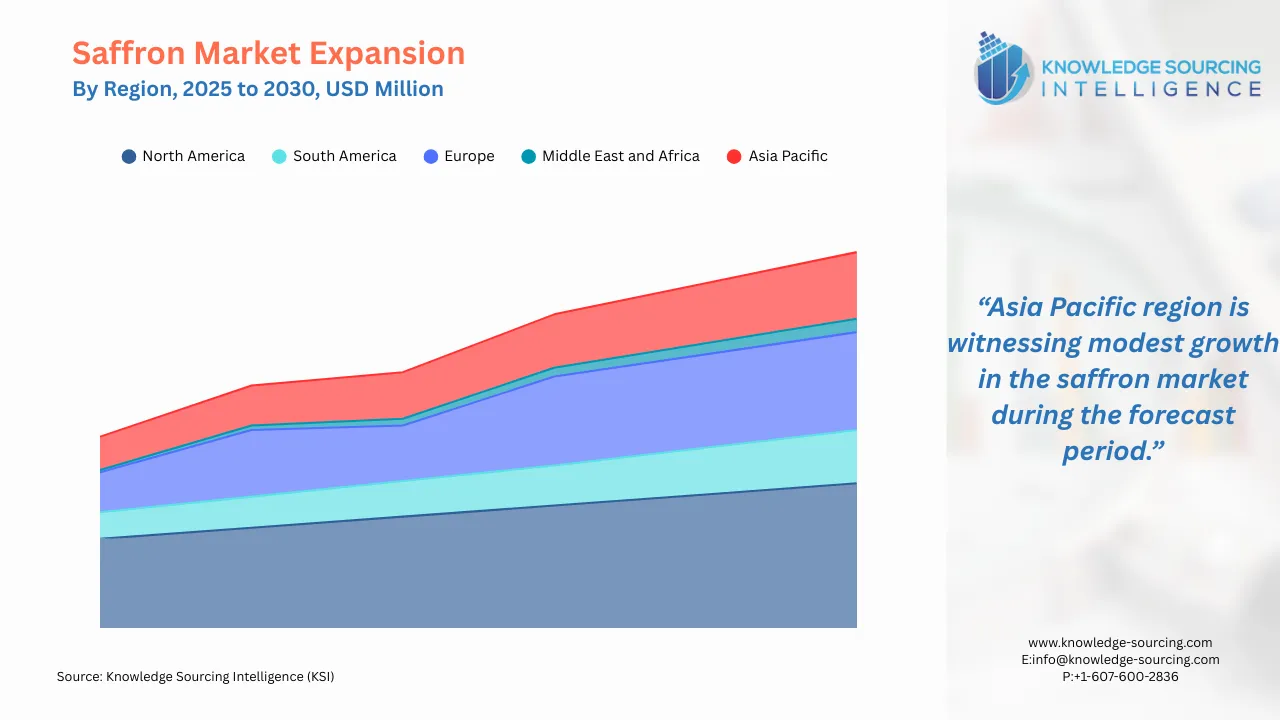Global Saffron Market - Strategic Insights and Forecasts (2025-2030)
Description
Saffron Market Size:
The global saffron market is projected to grow at a CAGR of 5.86%, from US$892.290 million in 2025 to US$1,186.460 million in 2030.
Saffron Market Key Highlights:
- The market is expanding steadily, projected to reach over US$1,186 million by 2030.
- Rising consumer demand is driven by saffron's proven antioxidant and mood-enhancing health benefits.
- Saffron is increasingly popular in gourmet cuisine, from traditional dishes to modern desserts and beverages.
- Its use as a natural food colorant is growing, replacing synthetic alternatives.
- Companies are innovating with saffron-based supplements, premium packaging, and technology to improve cultivation.
Saffron is the dried stigma of the Crocus sativus flower, also called the saffron crocus. This spice is valued for its bright golden-yellow color, distinctive flavor, and aromatic properties, which have been widely used in food, medicine, and cosmetics. Native to regions such as Iran, India, and Spain, saffron is one of the most expensive spices in the world because of the labor-intensive process of harvesting, where the delicate stigmas are handpicked.
Moreover, increasing health awareness with its antioxidant, anti-inflammatory, and mood-enhancing benefits creates demand for the ingredients in dietary supplements and functional foods. Unique flavor, aroma, and intense color have encouraged an increased adoption of traditional cuisine, gourmet recipes, and drinks worldwide. Demand from natural and organic product-seeking consumers continues to rise, with saffron offering clean-label status and high-premium potential.

To learn more about this report, request a free sample copy
Saffron Market Growth Drivers:
- Increasing disposable income has led to an increase in the consumption of premium quality natural colorings and premium foods
The surge in industrialization and urbanization has created more jobs and a rise in disposable income for low-income and middle-income populations. This has increased their propensity to spend on premium food products containing top-of-the-line ingredients and expensive spices such as saffron. In addition, individuals are shifting their preference towards natural food colorings due to the presence of unknown and potentially harmful substances in artificial food coloring. Hence, these factors are propelling the demand for saffron and fueling the market growth over the forecast period.
The use of saffron to give different foods and beverages a distinct and good flavor has been in trend for many years, and it is being used in different cuisines. For example, saffron is used in French cuisine in the popular fish stew dish called “Bouillabaisse.” It is used in Italian cuisine in “Risotto”. It is one of the main ingredients in the Spanish “Paella’ and is used as a flavor enhancer and to impart color to rice in “Biryani,” a very popular dish in the South Asian region. In addition, it is used to make ready-to-drink beverages like “Saffron Milk”, which is also gaining popularity. Thus, this is leading to the demand for saffron.
On the other hand, the trend of consuming saffron as a mode of nutrition is gaining a rapid following among individuals in different regions owing to its host of nutritional benefits. Saffron is widely used as it has an abundant number of antioxidants, including crocin, crocetin, safranal, and kaempferol. The compounds crocin and crocetin are excellent anti-depressants that can uplift the mood of consumers, whereas safranal helps in improving the memory of individuals.
In addition, according to the National Institute of Health, the consumption of saffron is effective in preventing cancer of the bone marrow, breast, and lungs, among others, to some extent. Premenstrual syndrome (PMS), which is the situation that affects the mood and psychology of a majority of women before the start of the menstruation cycle, can be controlled to some extent by the use of saffron. Besides, it has other health benefits apart from the abovementioned benefits. Thus, these factors are strengthening the position of the nutrition segment over the forecast period.
- Rising product innovations by key market players
Increasing innovations in the product line of major players are driving the saffron market expansion. Companies are inventing new saffron-based products such as ready-to-use formulations, dietary supplements, skincare items, and premium packaged saffron threads to fulfill the diverse needs of consumers.
Abad GuerraSaffron & Spices Exporters, one of the companies dealing in saffron production and export, offers different saffron forms under their product portfolio. They are offering Saffron in Threads, a product consisting of whole saffron threads that include style and stigma. They offer Coupe Saffron, which is the red part of the saffron's stigma, produced after the separation process from the style. The final product they offer is powdered saffron, which is obtained after grinding the saffron threads. They provide these products in different packing styles, such as showcase jars, blisters, sachets, and vials.
Additionally, Rowhani Saffron Co., a company that provides saffron, offers different types and grades to cater to the rising demand in various industries. It offers a product called the “Poushali Negin Saffron”, which is one of the best quality saffron that is available and shows features such as high porosity, all red, thicker fibers, and is cultivated and processed according to the ISO 3632 certification. It offers “Sargol Saffron”, which is considered one of the most colorful types of saffron. It is most commonly used for cooking, contains a high level of crocin and safranal, and adheres to the ISO 3632 certification. Moreover, the company also provides other types of saffron.

Saffron Market Geographical Outlook:
- The global saffron market is segmented into five regions worldwide
Geography-wise, the global saffron market is divided into North America, South America, Europe, the Middle East and Africa, and Asia Pacific. The Asia Pacific region is expected to hold a considerable market share over the forecast period, attributable to the increasing use of saffron in the medicinal, nutrition, and food sectors. Disposable Personal Income in China increased to 51,821 CNY in 2023 from 49,282.94 CNY in 2022. This figure in China averaged 14,124.48 CNY from 1978 until 2023, reaching an all-time high of 51,821.00 CNY in 2023.

On the other hand, the North American region is expected to hold a significant share during the forecast period owing to increasing disposable income among the people. This is encouraging them to use expensive spices, and the popularity of saffron is increasing in the food and beverage and cosmetics industries.
List of Top Saffron Companies:
- The Saffron Company JJ, S.L.
- Kashmir Kesar Leader
- SAFFRON Group
- Afghanistan Saffron Co
- Esfedan Saffron Co.
Saffron Market Scope:
| Report Metric | Details |
| Saffron Market Size in 2025 | US$892.290 million |
| Saffron Market Size in 2030 | US$1,186.460 million |
| Growth Rate | CAGR of 5.86% |
| Study Period | 2020 to 2030 |
| Historical Data | 2020 to 2023 |
| Base Year | 2024 |
| Forecast Period | 2025 – 2030 |
| Forecast Unit (Value) | USD Million |
| Segmentation |
|
| Geographical Segmentation | North America, South America, Europe, Middle East and Africa, Asia Pacific |
| List of Major Companies in the Saffron Market |
|
| Customization Scope | Free report customization with purchase |
The global saffron market is analyzed into the following segments:
- By Application
- Food and Beverage
- Cosmetics
- Nutrition
- Others
- By Geography
- North America
- USA
- Canada
- Mexico
- South America
- Brazil
- Argentina
- Rest of South America
- Europe
- United Kingdom
- Germany
- France
- Italy
- Spain
- Rest of Europe
- Middle East and Africa
- Saudi Arabia
- UAE
- Rest of the Middle East and Africa
- Asia Pacific
- China
- India
- Japan
- South Korea
- Taiwan
- Thailand
- Indonesia
- Rest of Asia-Pacific
- North America
Our Best-Performing Industry Reports:
Navigation
- Saffron Market Size:
- Saffron Market Key Highlights:
- Saffron Market Growth Drivers:
- Saffron Market Geographical Outlook:
- List of Top Saffron Companies:
- Saffron Market Scope:
- Our Best-Performing Industry Reports:
Page last updated on: September 11, 2025
Frequently Asked Questions (FAQs)
The saffron market is expected to reach a total market size of US$1,186.460 million by 2030.
Saffron Market is valued at US$892.290 million in 2025.
The global saffron market is expected to grow at a CAGR of 5.86% during the forecast period.
Individuals are shifting their preference toward natural food colourings due to the presence of unknown and potentially harmful substances in artificial food colouring. Hence, these factors are propelling the demand for saffron and fueling market growth.
The Asia Pacific region is expected to hold a considerable share in the saffron market, which is attributable to the increasing uses of saffron in the medicinal field, in nutrition and in foods.
Table Of Contents
1. INTRODUCTION
1.1. Market Overview
1.2. Market Definition
1.3. Scope of the Study
1.4. Market Segmentation
1.5. Currency
1.6. Assumptions
1.7. Base and Forecast Years Timeline
1.8. Key Benefits for the Stakeholders
2. RESEARCH METHODOLOGY
2.1. Research Design
2.2. Research Process
3. EXECUTIVE SUMMARY
3.1. Key Findings
3.2. Analyst View
4. MARKET DYNAMICS
4.1. Market Drivers
4.2. Market Restraints
4.3. Porter’s Five Forces Analysis
4.3.1. Bargaining Power of Suppliers
4.3.2. Bargaining Power of Buyers
4.3.3. The Threat of New Entrants
4.3.4. Threat of Substitutes
4.3.5. Competitive Rivalry in the Industry
4.4. Industry Value Chain Analysis
5. GLOBAL SAFFRON MARKET BY APPLICATION
5.1. Introduction
5.2. Food and Beverage
5.3. Cosmetics
5.4. Nutrition
5.5. Others
6. GLOBAL SAFFRON MARKET BY GEOGRAPHY
6.1. Global Overview
6.2. North America
6.2.1. United States
6.2.2. Canada
6.2.3. Mexico
6.3. South America
6.3.1. Brazil
6.3.2. Argentina
6.3.3. Rest of South America
6.4. Europe
6.4.1. United Kingdom
6.4.2. Germany
6.4.3. France
6.4.4. Italy
6.4.5. Spain
6.4.6. Rest of Europe
6.5. Middle East and Africa
6.5.1. Saudi Arabia
6.5.2. United Arab Emirates
6.5.3. Rest of the Middle East and Africa
6.6. Asia-Pacific
6.6.1. China
6.6.2. India
6.6.3. Japan
6.6.4. South Korea
6.6.5. Taiwan
6.6.6. Thailand
6.6.7. Indonesia
6.6.8. Rest of Asia-Pacific
7. COMPETITIVE ENVIRONMENT AND ANALYSIS
7.1. Major Players and Strategy Analysis
7.2. Market Share Analysis
7.3. Mergers, Acquisitions, Agreements, and Collaborations
7.4. Competitive Dashboard
8. COMPANY PROFILES
8.1. The Saffron Company JJ, S.L.
8.2. Kashmir Kesar Leader
8.3. SAFFRON Group
8.4. Afghanistan Saffron Co
8.5. Esfedan Saffron Co.
8.6. Tarvand Saffron Co.
8.7. Safrante Global Company, S.L.U.
8.8. Rowhani Saffron Co.
8.9. Safran
8.10. Saffron Tech
Companies Profiled
The Saffron Company JJ, S.L.
Kashmir Kesar Leader
SAFFRON Group
Afghanistan Saffron Co
Esfedan Saffron Co.
Tarvand Saffron Co.
Safrante Global Company, S.L.U.
Rowhani Saffron Co.
Safran
Saffron Tech
Related Reports
| Report Name | Published Month | Download Sample |
|---|---|---|
| Animal Protein Ingredients Market: Size, Trends, Forecast 2030 | August 2025 | |
| Food Sweeteners Market Report: Size, Share, Forecast 2030 | May 2025 | |
| Whey Protein Ingredients Market: Trends, Forecast 2025-2030 | August 2025 | |
| Peanut Butter Market Insights: Size, Share, Trends, Forecast 2030 | March 2025 | |
| Guanabana Market Report: Growth, Share, Trends, Forecast 2030 | January 2025 |